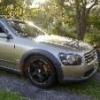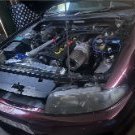Announcements
-
Similar Content
-
Latest Posts
-
By DraftySquash · Posted
So.... when I'm finally getting around to having my power steering leak sorted, now it looks like I've got the same issue most A/T Skylines are having. My A/T light will randomly come on and I'm stuck in 3rd gear until I turn the car off and on again. Only 3 weeks ago I did a complete transmission service: Oil flush + new gasket + new filter. This came out of nowhere!! It wasn't like the car was driven hard. I drove about 3 mins down the road to get fuel and boom!!! Anyway, I have a few questions and hope you fine people can help me out here. All questions are in red. 1. The solenoids: I was looking at the parts catalogue in Amayama and I could only find the Solenoids as an assembly. https://www.amayama.com/en/part/nissan/319404ax05 I read in another thread that Solenoid A = 31940-4AX02 & Solenoid B = 31940-4AX05 but the Amayama product has only the code of B. Is this the right part? Can anyone who has done the Solenoid changes or seen them confirm if this is the complete set of A & B? 2. Gasket and Filter: I'm not going to try change the solenoids myself because it seems difficult to do in a home garage with just 2 jack stands. I plan to take it to a shop and get it changed. I was also going to buy the transmission sump gasket at the same time so I don't reuse the same gasket. Should I just use the existing gasket as it has only been on the car since OCT 19th? (~3 weeks) Should I be buying a brand-new gasket and a filter? Does this job involve taking the filter out? Thanks in advance to everyone. It's hard to find a video of someone doing a solenoid change on a R34 so any help you can give answering my remaining questions would make me less stressed. -
Yea - From what I have seen from the video, the car idles like any R34 lol 50PSI of fuel pressure is hardly super abnormal, the regulator is working because the pressure remains static when the throttle gets revved, i.e pressure remains the same when manifold vaccuum changes. Bigger pumps on stock rails always bumped the pressure in the rail without using an aftermarket regulator to change that. Do you know what your IAC is actually doing? Has there been any data showing the stepper motor % etc? There's no way your idle is actually moving around the way the cluster(s) are indicating. You would hear the difference with the engine RPM flying to 3k and 1k in mere seconds. I'd be checking the wiring to the tacho. What the tacho is telling you and what the engine/ecu is telling you are different things. I assume your ECU doesn't display the spike. So whatever is telling the tacho to be at X rpm is doing something weird. When the going gets insane, you're on the wrong path. You've ruled out plenty of things that are working correctly/aren't the issue. Your idle isn't doing what the tacho is indicating. You have two seperate issues, I don't think they are linked, and the idle seems reasonably okay unless it's stalling which.. well, it hasn't. Troubleshoot the stall if it occurs by figuring out what your IAC is doing vs what it is being told to do.
-
So awesome! I love the RB with the exhaust on display.
-
By Just_a_datsun · Posted
NO HITS PRICE DROP ENGINE - $8.5k ONO TRANSMISSION - $1.8k ONO -
If it has had a code in the recent past, the code should still be there waiting to be read.
-







Recommended Posts
Create an account or sign in to comment
You need to be a member in order to leave a comment
Create an account
Sign up for a new account in our community. It's easy!
Register a new accountSign in
Already have an account? Sign in here.
Sign In Now